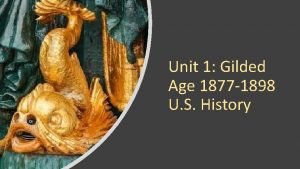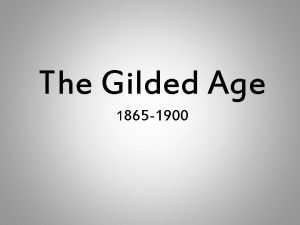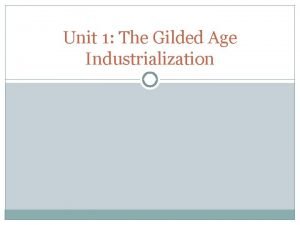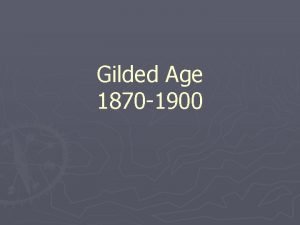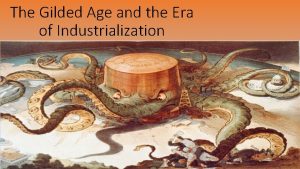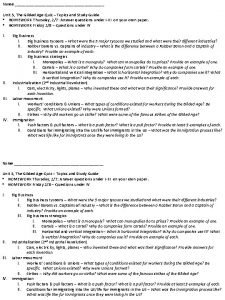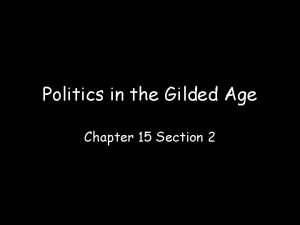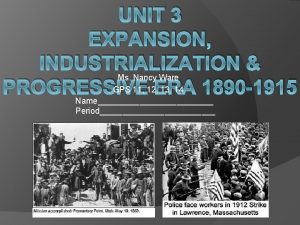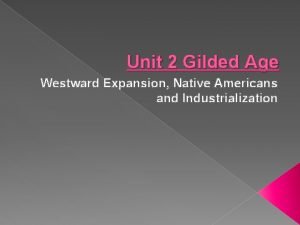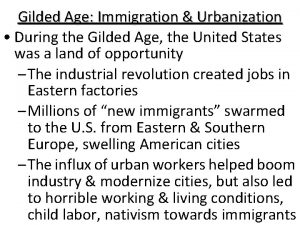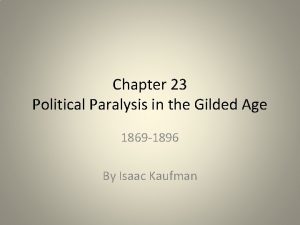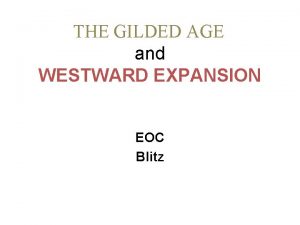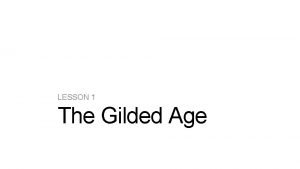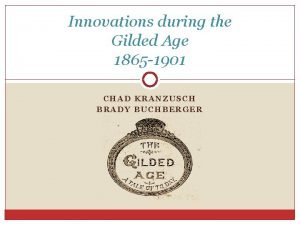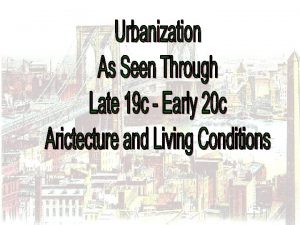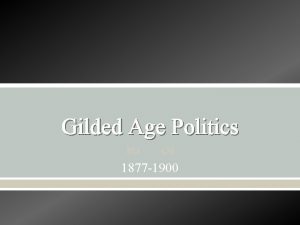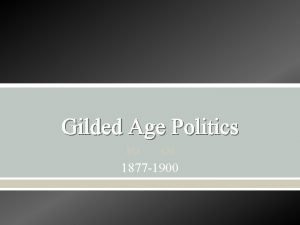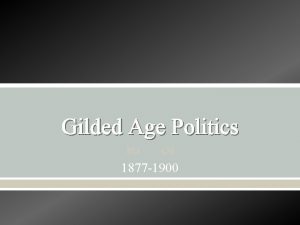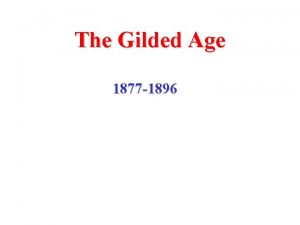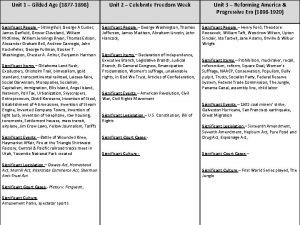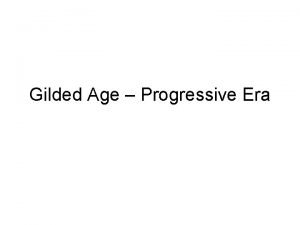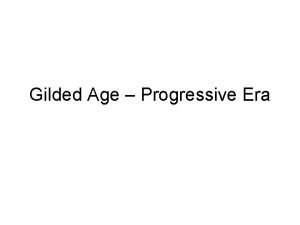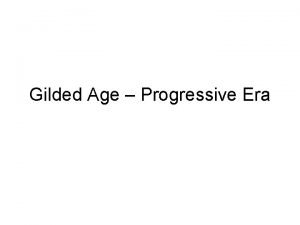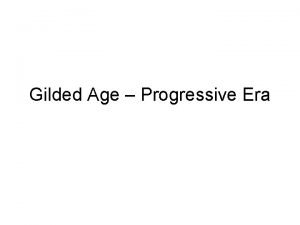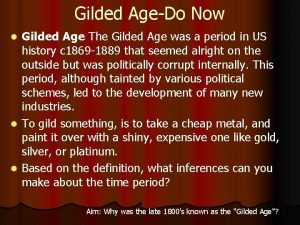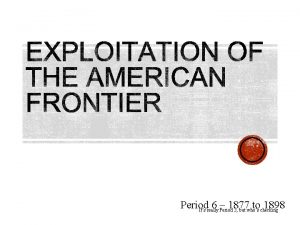Gilded Age PERIOD 6 1877 1898 Gilded Age




















- Slides: 20

Gilded Age PERIOD 6: 1877 – 1898

Gilded Age Period after Reconstruction from 1870 s to 1900, defined by gross materialism and political corruption. Characterized by a shallow display and worship of wealth.

Gilded Age Era of industrial expansion Gold-plated Extreme Agrarian Growth rich & poor Industrial of big businesses ran by “robber barons”

Reasons for Industrial Growth Availability of cheap labor (immigrants) Expansion of railroads led to other industries (steel & oil) Lower-cost production (vertical integration) Inventions (telephone & light bulb) Improved communication Factories can run 24 hours Financial resources (investments) Access to raw materials & energy

Big Business - Oil John D. Rockefeller Standard Oil Horizontal integration – trust Monopolized the industry

Big Business - Steel Andrew Carnegie Steel Instrumental in the construction of RRs Bessemer process (Henry Bessemer); replaced by the openhearth process Vertical integration – controlling all aspects of production Philanthropist

Big Business - Railroads Cornelius Vanderbilt Jay Gould


Work Force (Immigrants) Change in origin of immigrants Immigrant stations Ellis English Irish & Germans Eastern & Southern Europe Angel Settled in ethnic communities Island (NY) – 1892 Island (CA) – 1910 Chinese Exclusion Act (1882)

Regulation of Big Business Regulation is strongly opposed Laissez-faire hands off approach “De-skilling” of the work process; no more craftsmen Great Railroad Strike – 1877 Decline in wages Violence erupts across the country Military is sent to stop the strikes Haymarket Incident – 1886 Striking workers attacked the “scabs” Bomb explodes at a rally, killing police open fire on the crowd KOL’s popularity declines Labor Unions Knights of Labor – welcomed all American Federation of Labor – skilled workers only (Samuel Gompers)

Regulation of Big Business Pullman Strike – 1893 Company town – Pullman, Illinois Better housing but more costly Wages were cut, but not their rent American Railway Union (ARU) – Eugene Debs Workers strike & railroad traffic is halted Pres. Cleveland sends troops 25 strikers are killed Supreme Court decides the govt can stop strikes

Success & Obligation Wealthy class justified their success with the idea of “Social Darwinism” Survival of the fittest Inequality of wealth is part of the process Carnegie argued that the wealthy had an obligation to give back to communities “The Gospel of Wealth” Improved cities Enhance educational opportunities

The “New South” Encouraged industrialization of the south Henry Grady wanted mixed economy Some textile factories South is still dominated by tenant farming & sharecropping Cycle of poverty for AAs & poor whites Impact of mechanized farming More production falling prices Hurt small-scale farmers Unfair RR business practices Expensive machinery Tight money supply High tariffs Populist Party – 1892 AKA People’s Party

Populist Party Platform Govt ownership of RRs (so prices could be regulated) Free & unlimited coinage of money (increase $ supply) Graduated income tax Direct election of senators (17 th Amendment) Use of initiative & referendums attempts to limit corruption & power of big businesses

Native Americans Decline in buffalo Hunted by RR workers & frontiersmen for mostly sport Undermines the Natives’ existence Boarding schools Carlisle Institute Assimilate Native Americans Cut their hair, no traditional clothes, & must practice Christianity “Kill the Indian, save the man” Reservations Dawes Severalty Act (1887) Not good for farming End tribal ownership of land Resistance Ghost Dance Battle of Little Big Horn (1876) – Custer’s Land Stand – US Army defeated by the Sioux tribe Massacre at Wounded Knee (1890) Last of the “Indian Wars”

Movement of People Internal Migration Rural urban areas Homestead Act Transcontinental RR (Promontory Point, Utah – 1896) – Govt land grants “Great Migration” of AAs out of the south – peaks during WWI & WWII External Migration New immigrants from southern & eastern Europe; and Chinese Increased Nativism Immigrant labor will construct the Transcontinental RR (Chinese west; Irish east) Chinese Exclusion Act (1882) Suspended Chinese immigration Limited civil rights of Chinese residents Forbade Chinese naturalization City living – tenement housing Substandard living conditions Crowded Lacked running water, sewage & garbage removal Jacob Riis “How the Other Half Lives”

Urban Living

Challenges & Reforms Settlement houses Assisted immigrants & women Jane Addams – Hull House in Chicago Temperance Mann Act – 1910 Crack down on prostitution Tammany Hall – “political machines” run by party “bosses” Anti-Saloon League William March Tweed – “Boss Tweed” Women’s Christian Temperance Union Provided benefits to immigrants - jobs Exposed by Thomas Nast (cartoonist) Complemented the nativist movement

African Americans Segregation worsens AAs are treated like second-class citizens Some argue the treatment is against the 14 th Amendment Slaughterhouse cases (1873) Plessy v. Ferguson (1896) Ida B. Wells Active in women’s rights movement & anti-lynching campaign Booker T. Washington Tuskegee Institute Advocated AAs acquire vocational skills to gain respect & economic security Ideas will be challenged by W. E. B. Du. Bois “separate but equal”

Recreation Circuses – Barnum & Bailey Coney Island – Brooklyn, NY Central Park – NY Baseball – “national pastime” College Football
 The gilded age 1877 to 1898 worksheet answers
The gilded age 1877 to 1898 worksheet answers The gilded age time period
The gilded age time period Stone age, bronze age iron age timeline
Stone age, bronze age iron age timeline Iron age bronze age stone age timeline
Iron age bronze age stone age timeline Gilded age entrepreneurs
Gilded age entrepreneurs Gilded age presidents
Gilded age presidents Vertical integration gilded age
Vertical integration gilded age The gilded age quiz
The gilded age quiz Chapter 15 section 3 politics in the gilded age
Chapter 15 section 3 politics in the gilded age Political bosses apush
Political bosses apush The great railroad strike of 1877 was provoked by:
The great railroad strike of 1877 was provoked by: Promontory point gilded age definition
Promontory point gilded age definition Westward expansion acrostic poem
Westward expansion acrostic poem Urbanization during the gilded age
Urbanization during the gilded age Chapter 23: political paralysis in the gilded age
Chapter 23: political paralysis in the gilded age Us cavalry general whose unwise and reckless
Us cavalry general whose unwise and reckless Gained voter support by helping immigrants find jobs.
Gained voter support by helping immigrants find jobs. Chapter 15 section 3 politics in the gilded age
Chapter 15 section 3 politics in the gilded age Lesson 1 - politics and the gilded age
Lesson 1 - politics and the gilded age Gilded age inventions
Gilded age inventions Louis sullivan gilded age
Louis sullivan gilded age
